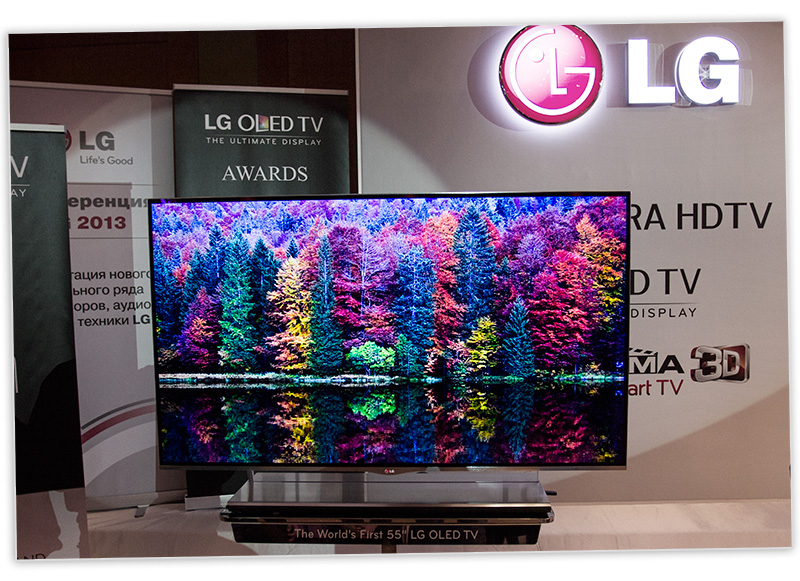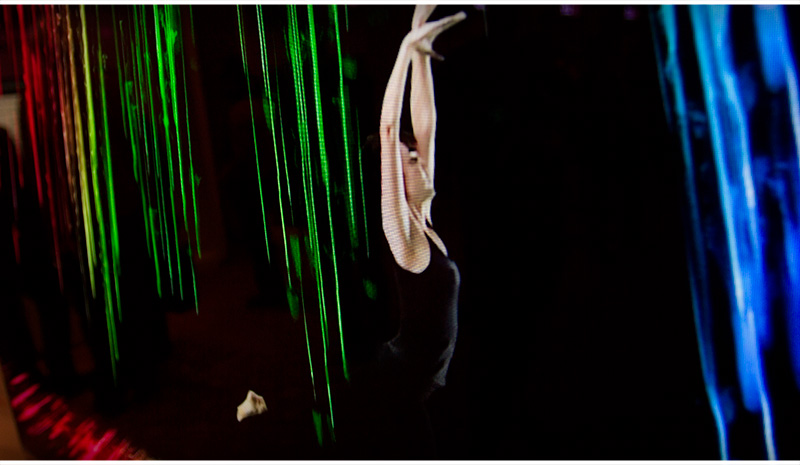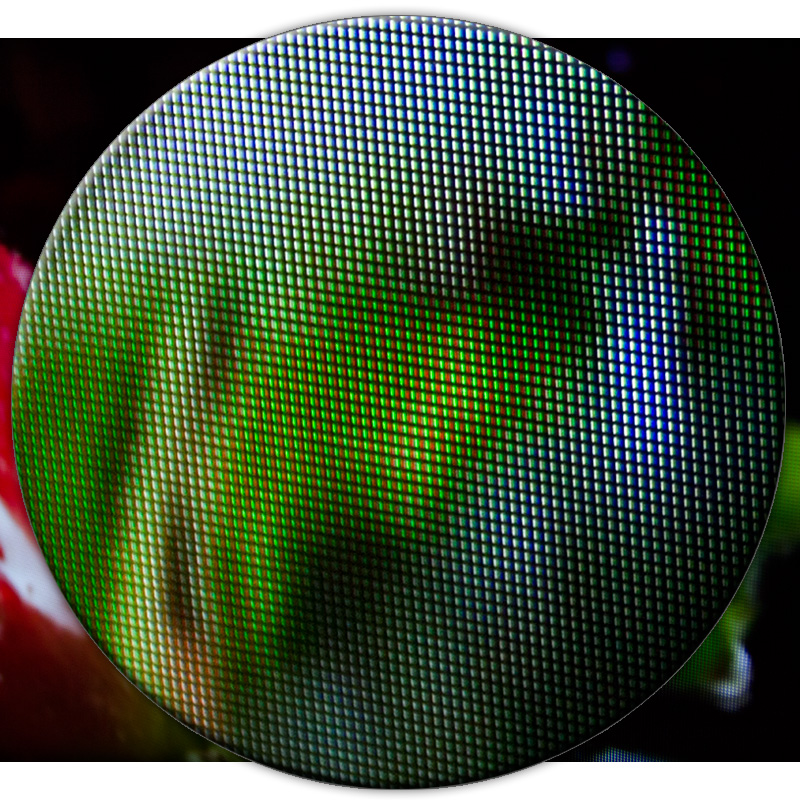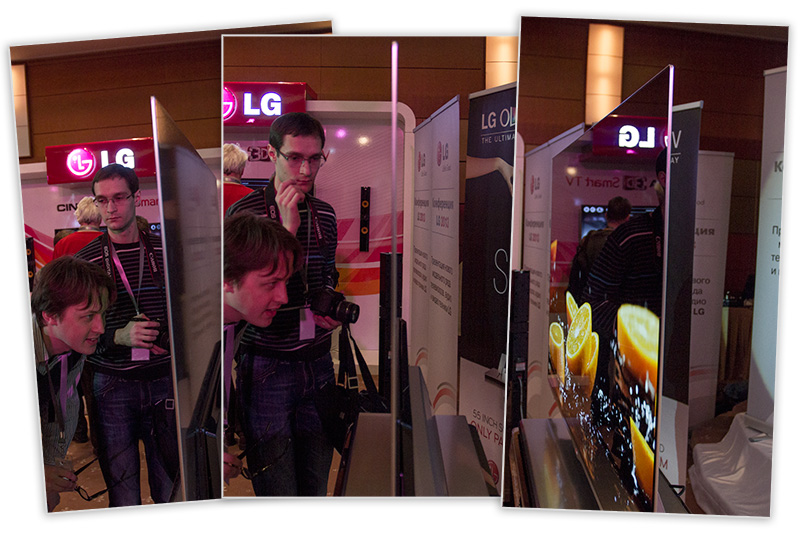LG 55EM9600 OLED TV - Television with a capital letter
Good day to all! Today we want to tell you about an unusual TV, which was recently presented at our presentation . It's about OLED TV, which can rightly be called one of a kind. Many manufacturers fought for the title of the first company to offer OLED TVs, which were available not only to owners of private oil wells, but we were the ones who were the first to do this.

Of course, the efforts of other vendors also deserve praise: they did not stand still and develop related industries, and this, in any case, sooner or later will lead to an improvement in the overall quality of the technology, but we want here and now innovation and stunning picture quality, so ... You are welcome under the cut, to find out what and how in the only model of OLED-TV, which left the showrooms and will appear on store shelves in a month or two.
The appearance of the TV, perhaps, can be characterized by the words "nothing superfluous." The thinnest frame around the screen, a simple and neat stand that holds all the connectors and electronics, and that’s all.

Few? And we said nothing superfluous. TV, you know, you need to watch the video, and not to collect fingerprints with glossy surfaces edging plastic. :)
')

Display:
Sound:
Ports and interfaces:
Technology:
There were many difficult moments. OLED-matrices have a lot of advantages (brightness, contrast), but the production of an OLED display of such a diagonal requires a streamlined and predictable production, as a defect in a product of this level is unacceptable.

OLED screens have been used for a long time in telephone construction, in an industry where it is especially important to maintain a good brightness / consumed power ratio. Some problems (such as the time between failures of blue LEDs and problems with obtaining a high resolution display) were partially or fully solved in mobile development), but the TV is not a smartphone, and the characteristics of the panels that meet the requirements of the communicator are insufficient to produce displays to be used on a 55 "TV.
The first problem is the brightness of the display. If there is no particular problem with phones, as they are used at a distance of up to 100 centimeters, the television screen, despite the highest contrast, may seem dull or dark. There are two ways to solve it - to reduce the ambient light, or to increase the display brightness. Since the “air suction device” cannot be done yet, and not everyone will agree to the total darkness in the room, it is necessary to raise the display brightness. This directly leads to an increase in both the power consumption and the heat generated. It is the problem of overheating of the matrix that many companies have faced that have tried to develop OLED TVs. We approached its solution in a complex.
The first thing that was asked was how to improve the brightness of the picture without increasing the power of the LEDs in the matrix by a significant amount. A simple and elegant solution was found - if 3 LEDs are used to get any shade from bright white to black, then you can use an additional white subpixel and reduce the load on the remaining color subpixels. This technology is called WRGB, and it has already been used previously in mobile phones.

In this picture you can see that the image is formed from separate luminous points.
The industry is able to produce bright white LEDs, and the presence of an additional point, not carrying a color load (that is, not having (due to a clamped color spectrum), but a full luminous flux at the same power consumption) allows to “shine” less in color subpixels when you want to display a light shade or just a white dot.

Zoom! Enhance!
In addition, the color rendition has improved in the typically weak segments of OLED-displays - in dark, gray and almost white colors the details are no longer lost, and the contrast remains the same high.

No! Just keep zooming!
The second improvement was the answer to the question: "how to increase heat dissipation without introducing active cooling." Agree, the cooler on the TV is a bust. The solution to improve the heat sink from the OLED panel was the case. Thin, neat, simple in appearance it is one big radiator for a matrix of 8 294 400 microscopic LEDs.

All electronics and connectors are located in the OLED-TV stand, allowing the use of almost the entire surface of the 55 "panel as a heat spreader.
Do not forget the developers and about 3D-content. The display matrix is covered with a special polarization material that separates even lines from odd lines, and gives the light emitted by them a corresponding polarization. If you look at such a screen without the appropriate glasses, screening out a portion of the rays for the left / right eye, then you see a normal image (in the case of viewing 3D, it is double). Points, eliminating the "wrong" lines, allow you to show the eye only the desired part of the picture. A simple and effective solution that does not require a separate power supply (or battery) for the glasses, double the frame rate, does not cause flickering of the LCD shutters or a stroboscopic effect when it is out of sync, and is almost independent of the angle at which you look at the display.
Well, we will not tell you tales about the amazing brightness and contrast: here is a video from the Russian presentation of this TV, see for yourself:
Black means black, white means white, and the color is the color, and on the part of the lively juiciness of the picture, not a single IPS-TV can so far with the OLED panel.

Of course, the efforts of other vendors also deserve praise: they did not stand still and develop related industries, and this, in any case, sooner or later will lead to an improvement in the overall quality of the technology, but we want here and now innovation and stunning picture quality, so ... You are welcome under the cut, to find out what and how in the only model of OLED-TV, which left the showrooms and will appear on store shelves in a month or two.
1. Appearance
The appearance of the TV, perhaps, can be characterized by the words "nothing superfluous." The thinnest frame around the screen, a simple and neat stand that holds all the connectors and electronics, and that’s all.

Few? And we said nothing superfluous. TV, you know, you need to watch the video, and not to collect fingerprints with glossy surfaces edging plastic. :)
')

2. Characteristics
Display:
- Diagonal - 55 inches;
- Resolution - 1920x1080p;
- Response speed (GtG) - 1ms;
- The lack of a backlight system (every pixel is lit in the matrix).
Sound:
- Built-in stereo speakers
- Ability to connect an external audio system via a digital output
Ports and interfaces:
- 4x HDMI 1.3
- 3x USB 2.0
- 1x Ethernet
- 1x 3.5mm MiniJack
- 1x VGA (D-sub)
- 1x Component (YPbPr / YCbCr) input
Technology:
- Support for LG Smart TV 2013;
- LG Cinema 3D support;
3. Technical problems and solutions
There were many difficult moments. OLED-matrices have a lot of advantages (brightness, contrast), but the production of an OLED display of such a diagonal requires a streamlined and predictable production, as a defect in a product of this level is unacceptable.

OLED screens have been used for a long time in telephone construction, in an industry where it is especially important to maintain a good brightness / consumed power ratio. Some problems (such as the time between failures of blue LEDs and problems with obtaining a high resolution display) were partially or fully solved in mobile development), but the TV is not a smartphone, and the characteristics of the panels that meet the requirements of the communicator are insufficient to produce displays to be used on a 55 "TV.
The first problem is the brightness of the display. If there is no particular problem with phones, as they are used at a distance of up to 100 centimeters, the television screen, despite the highest contrast, may seem dull or dark. There are two ways to solve it - to reduce the ambient light, or to increase the display brightness. Since the “air suction device” cannot be done yet, and not everyone will agree to the total darkness in the room, it is necessary to raise the display brightness. This directly leads to an increase in both the power consumption and the heat generated. It is the problem of overheating of the matrix that many companies have faced that have tried to develop OLED TVs. We approached its solution in a complex.
The first thing that was asked was how to improve the brightness of the picture without increasing the power of the LEDs in the matrix by a significant amount. A simple and elegant solution was found - if 3 LEDs are used to get any shade from bright white to black, then you can use an additional white subpixel and reduce the load on the remaining color subpixels. This technology is called WRGB, and it has already been used previously in mobile phones.

In this picture you can see that the image is formed from separate luminous points.
The industry is able to produce bright white LEDs, and the presence of an additional point, not carrying a color load (that is, not having (due to a clamped color spectrum), but a full luminous flux at the same power consumption) allows to “shine” less in color subpixels when you want to display a light shade or just a white dot.

Zoom! Enhance!
In addition, the color rendition has improved in the typically weak segments of OLED-displays - in dark, gray and almost white colors the details are no longer lost, and the contrast remains the same high.

No! Just keep zooming!
The second improvement was the answer to the question: "how to increase heat dissipation without introducing active cooling." Agree, the cooler on the TV is a bust. The solution to improve the heat sink from the OLED panel was the case. Thin, neat, simple in appearance it is one big radiator for a matrix of 8 294 400 microscopic LEDs.

All electronics and connectors are located in the OLED-TV stand, allowing the use of almost the entire surface of the 55 "panel as a heat spreader.
Do not forget the developers and about 3D-content. The display matrix is covered with a special polarization material that separates even lines from odd lines, and gives the light emitted by them a corresponding polarization. If you look at such a screen without the appropriate glasses, screening out a portion of the rays for the left / right eye, then you see a normal image (in the case of viewing 3D, it is double). Points, eliminating the "wrong" lines, allow you to show the eye only the desired part of the picture. A simple and effective solution that does not require a separate power supply (or battery) for the glasses, double the frame rate, does not cause flickering of the LCD shutters or a stroboscopic effect when it is out of sync, and is almost independent of the angle at which you look at the display.
Well, we will not tell you tales about the amazing brightness and contrast: here is a video from the Russian presentation of this TV, see for yourself:
Black means black, white means white, and the color is the color, and on the part of the lively juiciness of the picture, not a single IPS-TV can so far with the OLED panel.
Source: https://habr.com/ru/post/180035/
All Articles